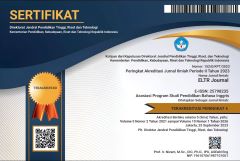CHALLENGES IN IMPLEMENTING PREPOSITIONS OF TIME, PLACE AND DIRECTION FOR FIRST SEMESTER STUDENTS OF ENGLISH LANGUAGE EDUCATION STUDY PROGRAM
Abstrak terlihat: 849 / PDF terunduh: 958DOI:
https://doi.org/10.37147/eltr.v2i2.97Keywords:
Preposition, English proficiency, difficulties in using prepositions, DPA class,Abstract
This study examined the English proficiency of English Language Education Study Program students, with main focus the use of prepositions of time, place and direction. The researchers discussed the difficulties of first semester students in using these prepositions properly in the sentences. The participants of this research were the first semester students of English Language Education Study Program at Sanata Dharma University. The researchers invited 43 students in the DPA class. The data of this research were collected from questionnaires and Cloze Tests. The collected data from questionnaires were analyzed based on Likert Scale. The data resulted from Cloze Tests were concluded using Level of Achievement Score. The results confirmed that the students experienced the difficulties in using the preposition of place and direction than the preposition of time. The findings revealed that the students were confused in the use of words in, on, and toward. Furthermore, the findings imply that the students should pay more attention to the prepositions and need to find the best strategies to acquire them.
Downloads
References
AlQbailat, N. M. (2016). Prepositions in use: Prepositions of standard, prepositions of possession and prepositions of accompaniment. Advances in Language and Literary Studies, 7(4). Retrived from http://www.journals.aiac.org.au/index.php/alls/article/view/2350
Ary, D., Jacobs, L. C., & Razavieh, A. (2002). Introduction to research in education (6th ed.). USA: Wadsworth group.
Bram, B. (2005). Some common problems involving prepositions in writing English in a multilingual context. Retrived from http://www.academia.edu
Brown, H. D. (2004). Language assessment: Principles and classroom practices. New York: Pearson Education.
Chodorow, M., Tetreault, J. R., & Han, N. R. (2007). Detection of grammatical errors involving prepositions. In Proceedings of the Fourth ACL-SIGSEM Workshop on Prepositions. Association for Computational Linguistics. Retrieved from https://dl.acm.org/citation.cfm?id=1654635
Cabuk, S. (2009). The use of preposition in second language acquisition process. Middle East Technical University. Retrieved from
http://citeseerx.ist.psu.edu/viewdoc/download?doi=10.1.1.632.9192&rep=rep1&type=pdf
Delijah, S., & Ogerta K. (2013). Challenges in teaching prepositions in a language classroom. University of Tirana. Retrieved from
https://www.iiste.org/Journals/index.php/JEP/article/viewFile/6783/6896
Eddine, A. N. (2012). Interlanguage prepositions: An analysis of French learners’ productions in L2 English. Université de Grenoble. Retrived from https://tel.archives-ouvertes.fr/tel-01057881/document
Frank, M. (1972). Modern English: A practical reference guide. New Jersey: Prentice-Hall,Inc.
Galleguillos, C. F. (2013). The acquisition of english prepositions among Chilean EFL learners. Universidad De Chile. Retrived from http://repositorio.uchile.cl/bitstream/handle/2250/115654/Flores%20G.%20Carmen_2013.pdf;sequence=1
Ibrahim, A. A. M. (2017). The difficulties encounter (ESP) students in using English prepositions of time. International Journal of Humanities Social Sciences and Education (IJHSSE), 4. Retrived from https://www.arcjournals.org/pdfs/ijhsse/v4-i11/25.pdf
Islami, A. (2015). The main difficulties in mastering the English language prepositions. AAB College. Retrived from https://aab-edu.net/assets/uploads/2016/12/03-2015-EN-04-Avni-Islami.pdf
James, M. (2007). Interlanguage variation and transfer of learning. International Review of Applied Linguistics in Language Teaching (IRAL), 45(2), 95-118. Retrived from http://dx.doi.org/10.1515/IRAL.2007.004
Lindstromberg, S. (2010). English prepositions explained (revised ed.). Amsterdam: John Benjamin Publishing Company.
Mahmoodzadeh, M. (2012). A cross-linguistic study of prepositions in Persian and English: The effect of transfer. Theory and Practice in Language Studies, (2)4, 734-740. Retrived from http://www.academypublication.com/issues/past/tpls/vol02/04/12.pdf
Mahmudah, R. (2011). Improving students ability in using prepositions of place through Total Physical Response (TPR). Syarif Hidayatullah State Islamic University. Retrieved from
http://repository.uinjkt.ac.id/dspace/bitstream/123456789/3007/1/RIF%27ATUL%20MAHMUDAH-FITK.pdf
Mubarak, A. A. A. (2017). The complications of learning and understanding English prepositions among students at AL Imam AL Mahdi University in Sudan. Journal of Language Teaching and Research, 8(5), 871-880. Retrieved from http://www.academypublication.com/ojs/index.php/jltr/article/view/jltr0805871880
Mus, M. (2012). Students’ ability in using preposition: A case study at faculty of letters of Hasanuddin University. Retrieved from http://repository.unhas.ac.id
Ozisik, C. (2014). Identifying preposition errors of Turkish EFL students. ELT Research Journal. Retrived from http://dergipark.gov.tr/download/article-file/63637
Roslim, N. (2010). An overview of corpus linguistics studies on prepositions. Academy of Language Studies. Universiti Teknologi MARA. Retrived from https://www.researchgate.net/publication/314323973_An_Overview_of_Corpus_Linguistics_Studies_on_Prepositions
Saravan. J. (2014). The use of english prepositions: An empirical study. VV College of Engineering. Retrieved from
Yu, X. (2014). An analysis of prepositional error correction in TEM8 and its implications for FL learning. Theory and Practice in Language Studies, 4(3), 624-630. Retrieved from http://www.academypublication.com/issues/past/tpls/vol04/03/25.pdf
Downloads
Published
How to Cite
Issue
Section
License
Copyright (c) 2018 Imelda Woa Wene, Arima Renny Dayu Putri

This work is licensed under a Creative Commons Attribution-ShareAlike 4.0 International License.













